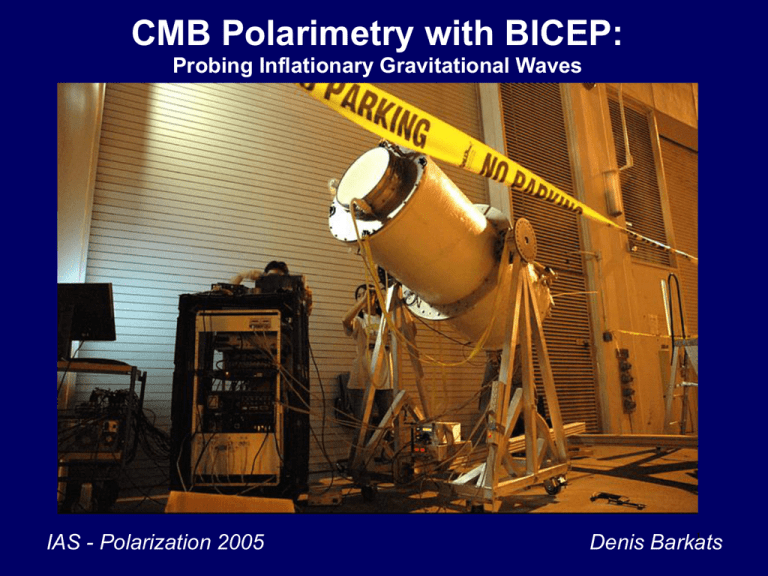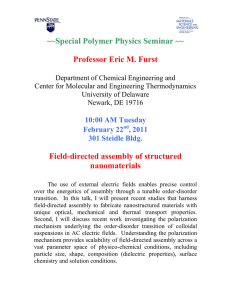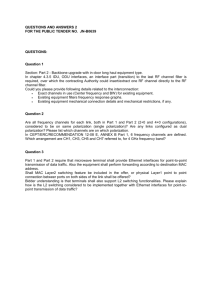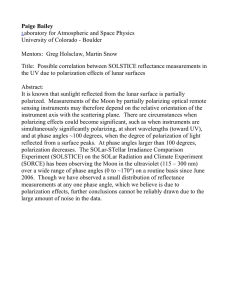CMB Polarimetry with BICEP: Probing Inflationary Gravitational Waves
advertisement

CMB Polarimetry with BICEP: Probing Inflationary Gravitational Waves IAS - Polarization 2005 1 Denis Barkats Background Imager of Cosmic Extragalactic Polarization Caltech / JPL Andrew Lange Denis Barkats John Battle James Bock Cynthia Chiang Darren Dowell Greg Griffin Viktor Hristov UC Berkeley Bill Holzapfel Yuki Takahashi CEA Grenoble Lionel Duband Eric Hivon John Kovac Chao-Lin Kuo Pete Mason Hien Nguyen Ian Sullivan Ki Won Yoon UC San Diego Brian Keating Evan Biermann Tom Renbarger Cardiff Peter Ade 2 State of the CMB polarization field in August 2005 EE and TE polarization WMAP BOOMERANG 03 CBI DASI CAPMAP BICEP What do we need? • Significant advance system sensitivity BB polarization • Control systematic Upper limits ~ 2 mK2 errors at < 0.1 mK levels • Distinguish from Galactic Foregrounds (from DASI,CMB CBI, B03) 3 T/S < 0.36 from CMB+LSS Signal from Lensing • Distinguish Gravity-wave Overview of the BICEP instrument Minimize polarization systematics • Simple refractor, no mirrors • Azimuthal symmetry • Alt-az telescope, with continuous boresight rotation • Wide-band polarization modulation with FRMs Optimize to 10 < < 400 • Beam sizes ~ 1 deg, 0.6 deg • Field of view ~ 17 deg • Observed sky fraction ~ 5% 10 cm thick Zotefoam window IR-blocking filters Cold polyethylene lenses Feed horn array Faraday rotators PSBs Separate CMB / foregrounds • Two frequency bands at 100 and 150 GHz Helium sorption refrigerator Signal-to-noise considerations • 49 light PSB pairs at 250 mK (98 bolos) • Multiple levels of modulation • South Pole location: long integration over contiguous patch of sky, reduced atmospheric loading Cryostat 4 New Technology: Polarization Sensitive Bolometers Parallel metal lines, Polarization in x-axis Polarization in y-axis Photon Courtesy of Jamie Bock, NASA JPL 5 Upward-looking cryostat with toroidal LN2 / LHe tanks Cryostat and mount Long hold time (4-5 days) Helium sorption fridge to cool focal plane to 250 mK Az-El mount + boresite rotation Rotation essential for map cross-linking 4He, 1.5 K 3He, 350 mK 3He, 250 mK 6 Hold time ~ 2 days, cycle ~ 5 hours 25 cm Front-end optics 180 cm • Telecentric design for flat focal plane • AR-coated filters and lenses • Cross-polarization < 0.01%, instrumental polarization < 1% from physical optics simulations Teflon Zotefoam Polyethylene IR-blocking window lenses filters 7 The BICEP insert Lens tube mounted on top of insert Drop-in focal plane Cold JFETs for signal buffering, refrigerator, thermal connections to focal plane Trussed structure to isolate 250 mK plate from 4 K All RF-sensitive components enclosed in large faraday cage 8 Full focal plane map 100 GHz 150 GHz • 49 spatial pixels = 98 polarizationsensitive bolometers • Divided into 6 similar hextants • Each hextant has 4 pixels at each band • Adjacent hextants measure Q and U. 9 Image: J. Kovac Image: K. Yoon A closer look at the focal plane Primary beam-defining feed horn (4 K) Faraday rotator module A photon's view of the focal plane Re-expanding horn (4 K) Polarizationsensitive bolometers Band-defining metal mesh filters, baffles Refocusing horn (250 mK) 10 Home, sweet (frozen) home: South Pole station, Antarctica “150 GHz band” “100 GHz band” Bandwidth: 24 GHz Bandwidth: 41 GHz Optical efficiency:27.5%Optical efficiency:25% 11 What can BICEP do for you? - Winter 2005 / 2006: deployment to south pole - Return information on polarized foreground emission - Measure EE polarization at intermediate , complementary to current detections BB polarization: if anyone's gonna do it (in the next N years), we will! N ~ number of years before SPIDER, EBEX, CMBpol, Planck etc. 1 year of Planck ~ 6 x sensitivity of 8 years of WMAP BICEP has similar instantaneous sensitivity to polarization as Planck, and is more sensitive to peak BB signal due to concentration on a small patch of sky Detect BB polarization if T/S > 0.05 (assuming “reasonable” integration time), otherwise set a bomber upper limit http://www.astro.caltech.edu/~lgg/bicep_front.htm 12 Expected BICEP performance System NET ~ 35 uK√s (350 uK√s per PSB, 98 detectors) EE BB Total integration time: somewhere between 100 days and 200 days Observed sky fraction ~ 5% Beam width ~ 1 degree T/S = 0.05 and t = 0.17 13







